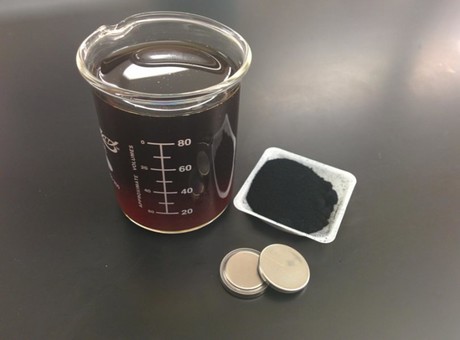Lithium-sulfur batteries made from paper biomass

Researchers at Rensselaer Polytechnic Institute are using cheap and abundant paper biomass to make rechargeable lithium-sulfur batteries, anticipated to be the next generation of battery.
Rechargeable lithium-ion batteries are currently the dominant battery technology. In recent years, however, much interest has grown around developing lithium-sulfur batteries, which can have more than double the energy of their lithium-ion counterparts of the same mass.
A rechargeable battery has two electrodes — a positive cathode and a negative anode. Placed in between the electrodes is a liquid electrolyte that serves as a medium for the chemical reactions that produce electric current. In a lithium-sulfur battery the cathode is composed of a sulfur-carbon matrix, while a lithium metal oxide is used for the anode.
In its elemental form, sulfur is nonconductive — but when combined with carbon at elevated temperatures it becomes highly conductive, allowing it to be used in novel battery technologies. The challenge is that sulfur can easily dissolve into a battery’s electrolyte, causing the electrodes on either side to deteriorate after only a few cycles.
Researchers have previously used different forms of carbon, such as nanotubes and complex carbon foams, to confine the sulfur in place, but with limited success. Trevor Simmons, a Rensselaer research scientist who developed the technology with his colleagues at the Center for Future Energy Systems (CFES), said, “Our method provides a simple way to create an optimal sulfur-based cathode from a single raw material.”
The material in question was lignosulfonate, a major by-product in the papermaking industry. This sulfonated carbon waste material is typically combusted on-site, releasing CO2 into the atmosphere after sulfur has been captured for re-use.
The Rensselaer researchers partnered with paper mill Finch Paper, which provided the lignosulfonate. The dark, syrupy substance was dried and then heated to about 700°C in a quartz tube furnace.
The high heat drives off most of the sulfur gas but retains some of the sulfur as polysulfides (chains of sulfur atoms) that are embedded deep within an activated carbon matrix. The heating process is repeated until the right amount of sulfur is trapped in the carbon matrix. The material is then ground up and mixed with an inert polymer binder to create a cathode coating on aluminium foil.
The research team has so far created a lithium-sulfur battery prototype that is the size of a watch battery, which can cycle about 200 times. The next step is to scale up the prototype to increase the discharge rate and the battery’s cycle life, with the ultimate goal of eventually powering big data centres and providing a cheaper energy-storage option for both microgrids and the traditional electric grid.
The news comes shortly after researchers at The University of Texas at Dallas developed their own lithium-sulfur battery, which used molybdenum to both improve stability and compensate for the poor conductivity of sulfur.
Predictive AI model enhances solid-state battery design
ECU researchers are working on ways to make solid-state batteries more reliable with the help of...
Boosting performance of aqueous zinc–iodine batteries
Engineers from the University of Adelaide have enhanced aqueous zinc–iodine batteries using...
Sodium-ion battery breakthrough boosts energy storage
Scientists have discovered that leaving water inside a key material, rather than removing it,...





